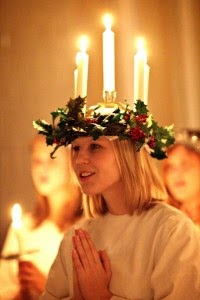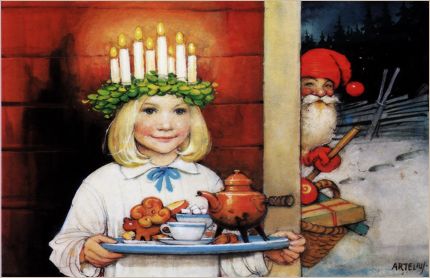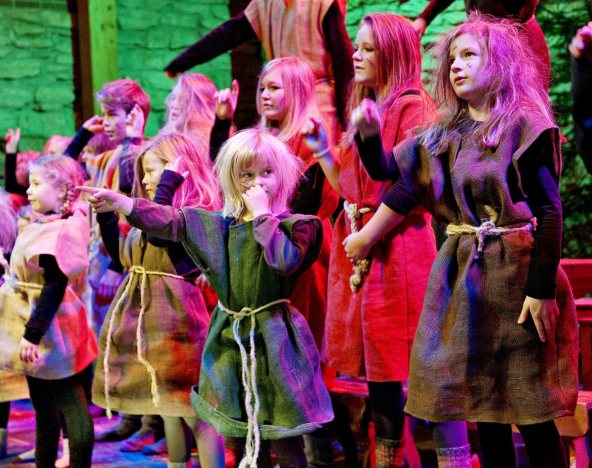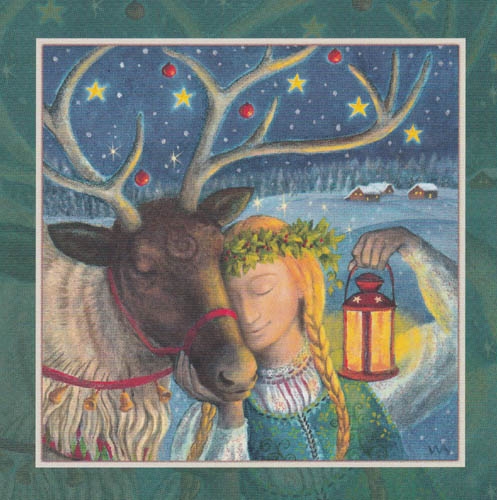
Today, December 13, marks the well known festival of Saint Lucia. But it is also a celebration for her lesser known counterpart, the witch Lussi. This is a magical time of delicious darkness as we wait for the Winter Solstice. Fairies, elves and all sorts of supernatural beings are said to be out and about on their Wild Hunt.
The Christian feast day of Saint Lucia is celebrated with songs, a procession, and a young girl being selected to play the role of Lucia. This girl wears a white robe with a red sash, and a crown of lingonberry greens with seven candles.
(A strategic balancing act! No fires reported so far.)

Originating in Sweden, these processions are now conducted in Finland, Denmark and Norway. (And sometimes the US and Canada.) In these cold and bleak nights before the Solstice, the vibrant figure of Lucia wearing a wreath of candles is a great reminder that the sun will soon be returning.
The chosen Lucia is at the center of a procession of girls, all clothed in white robes with red sashes as symbols of purity. They sing hymns and carry special cakes (called lussekatter.) However, the fairies and elves are also out on their Wild Hunt (called Oskoreia.) Traditions holds that if during the procession the girls hear the sound of the Wild Hunt behind them, they should toss one of the cakes over their shoulder to appease the elves.

Who was the real Santa Lucia? Ironically, she did not start out as a Swede. She was originally Sicilian. The story goes that Lucia was helping Christians hiding in the catacombs by bringing them food and water while they dodged persecution from the evil ruling empire. Lucia, always a resourceful girl, put candles on her head to light her way and was thus able to hold more food in her hands.
Lucia was martyred for her Christian activities in 304 CE. Legend has it they attempted to burn her on a pyre, but she remained alive. A Roman soldier then tried to kill her by slicing her throat. No luck. Stubborn Lucia did not die until she was given the Christian sacrament of Extreme Unction.
She became a very popular saint, and by the 6th century her feast day was honored in Anglo-Saxon England. Gradually she was acknowledged in Northern Europe, although the first Lucia candle processions were not recorded until the 19th century.
However, as with many legends, there is another, darker side to the story! Enter the witch Lussi.

Who is Lussi? A Nordic sorceress, close in parallel to the Germanic goddess Holle or Perchta. Not much is known about her, but she is said to be a powerful figure. She is the initiator of the Oskoreia and rides through the air with Odin and their followers – a troupe of wandering elves, fairies, nymphs and the like. They are called the Lussiferda, a band of trouble-making nuisances, out on a Wild Hunt intended to cause chaos and frighten humans.

December 13 is called Lussinatta or Lussi Night, a time to honor and fear her.
If you happen to see Lussi and her elven group, beware! Any human who encounters the Wild Hunt might be abducted to the Underworld. It is also believed that people’s spirits can be pulled away during their sleep to join the cavalcade. (So be very conscious of your dreams tonight. You might want to skip sleep altogether… More on that later.)
During the long nights between Lussinatta and Yule, trolls, daemons and the spirits of the dead are thought to be swirling about outside, enjoying the darkness. They are particularly active on Lussi Night. Naughty children are advised to hide away. According to some traditions, Lussi herself can come down through the chimney and abduct children who have been bad.

(Seems to me Lussi might be in kahoots with Krampus and Old Saint Nick…)
But adults should beware too. Lussi is particularly sensitive to all those dull and time consuming chores that must be done before Yule. You know — gathering wood for the fire, stocking the larder, salting the meat and making jam… If you (lazy human!) have not completed your winter tasks, you just may be abducted, along with your nasty children!
Some people do not want to take that chance, even in their dreams!
In a tradition called Lussevaka, folks would stay awake all through the long Lussi Night in order to guard themselves and their households against abductions. However, in the 21st century, Lussevaka has apparently taken on a different form. It’s called partying till the break of dawn!
If you don’t make it through the entire night, it still might be fun to stay up extra late tonight, light a few candles and be on watch for Lussi and her band of fairies.
Whether you choose the reverent road of singing hymns for Saint Lucia, or the decadent road of partying all night in hopes of seeing the Wild Hunt, have a jolly and elegant season as we wait for the return of the sun.

I had never heard of Lussi! I hope I can stay awake tonight! 🙂
LikeLiked by 1 person
Hehe! Seems it is a lesser known myth, but kind of cool that there is a dark counterpart to Lucia. I too will try to stay up!
LikeLiked by 1 person
Very interesting read.
LikeLiked by 1 person
Thanks so much! Glad you liked it 🙂
LikeLike
Great article shall remember to honour Lussi in future
LikeLiked by 1 person
Thanks! Glad you enjoyed it. She is so obscure, but it is fun to get the word out 🙂
LikeLike
Reblogged this on GrannyMoon's Morning Feast.
LikeLiked by 1 person
Fantastic as always, Christine! And now I know why I had those dreams on Lussi night!
LikeLiked by 1 person
Ahh, very interesting! I too had some weird dreams. (Did not stay up all night like I planned, haha!)
LikeLiked by 1 person
6 days ago a few things went bump in the night! May have been my son coming in but it could have been the Lussiferda, by your account, ‘a band of trouble-making nuisances, out on a Wild Hunt intended to cause chaos and frighten humans.’.
LikeLiked by 1 person
Perhaps so! Glad you survived it 🙂
LikeLiked by 1 person
So interesting…
LikeLiked by 1 person
Thanks! Glad you enjoyed it 🙂
LikeLiked by 1 person
My pleasure!
LikeLiked by 1 person
Such interesting reading – thank you!
LikeLiked by 1 person
Thanks, glad you liked it! A bit of a lesser known myth 🙂
LikeLike
[…] the night of December 13th, the dark witch Lussi (counterpart to the benevolent Santa Lucia) flies on her broom with the Wild Hunt of […]
LikeLiked by 1 person